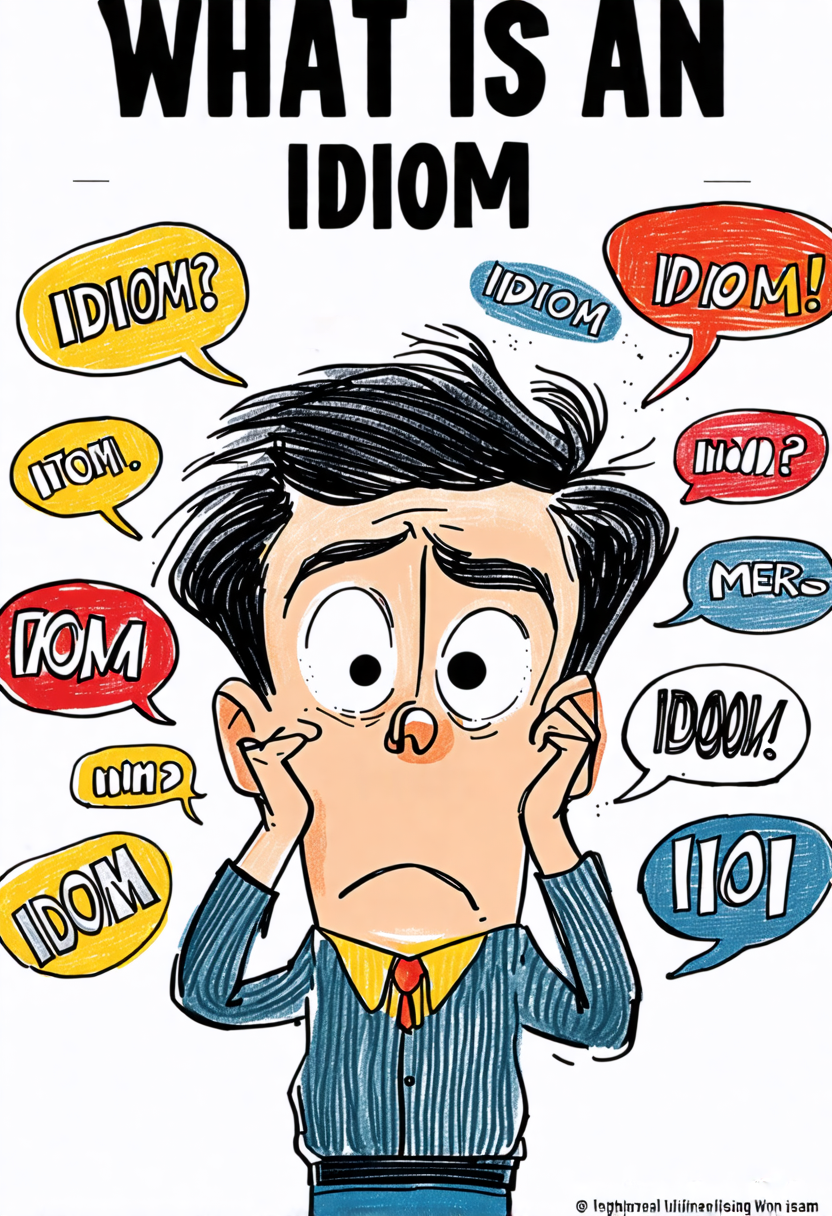What is an idiom?
An idiom is a phrase where the meaning differs from the literal definitions of the individual words. For example, “kick the bucket” means to die, not to physically kick a bucket. Idioms enrich language by adding nuance and color, often reflecting cultural or historical contexts. They can be confusing for non-native speakers due to their figurative nature.
Definition of Idioms
An idiom is a phrase or expression whose meaning cannot be inferred from the literal definitions of its individual words. Idioms are unique linguistic constructs that convey specific meanings, often rooted in cultural or historical contexts.
For example, the phrase ‘kick the bucket’ means to die, which cannot be understood by interpreting each word separately. These expressions are prevalent in everyday language and enrich communication by adding nuance and color.
Idioms can vary widely between languages and regions, reflecting local customs and traditions. They are essential for effective and engaging communication, often making conversations more relatable and vivid.
Types of Idioms
Lastly, understanding the various types of idioms enhances our grasp of their complexity and usage.
There are several types of idioms, each serving a unique function in language.
- Pure idioms are phrases with meanings that cannot be guessed from the individual words, like ‘spill the beans.’
- Binomial idioms consist of two words joined by a conjunction, such as ‘black and white.’
- Partial idioms have one word that retains its literal meaning, as in ‘make a difference.’
- Prepositional idioms are phrases where the meaning is influenced by a preposition, like ‘in a nutshell.’

Structure of Idioms
Although idioms vary widely in form, they generally rely more on syntax than strict grammatical rules. This means that the arrangement of words within an idiom is often fixed and changing it can alter or obscure its meaning.
For instance, the idiom ‘kick the bucket’ cannot be rearranged without losing its intended meaning of dying. Idioms often follow familiar sentence patterns but may include unusual word combinations. They can be short phrases like ‘under the weather’ or longer expressions such as ‘burn the midnight oil.’
Usage of Idioms
Idioms play an essential role in both written and spoken communication. Mastering idioms demonstrates proficiency and a deep understanding of the language’s subtleties.
Idioms enrich communication by adding creativity, cultural context, and emotional nuance. They make language engaging and relatable by conveying complex ideas succinctly.
In writing, idioms can add color and vivid imagery, making content more appealing. They help to establish a tone, whether it be casual or formal.
In everyday conversations, idioms strengthen connections and facilitate understanding between speakers. They reflect societal norms and cultural values, offering insights into a community’s way of thinking.
Idioms Vs. Clichés
While idioms enrich communication with creativity and cultural context, clichés often detract from originality and impact.
Idioms are unique phrases whose meanings cannot be deduced from their individual words. They add flavor and depth to language, making it engaging and relatable.
In contrast, clichés are phrases that have become overused and lost their original effectiveness. They fail to add new insights or emotions to communication, often causing the listener or reader to disengage.
Using idioms can make speech and writing more vivid and expressive. However, relying on clichés can make it seem uninspired and dull.
Idioms Vs. Proverbs
Proverbs and idioms both enrich language, but they serve different purposes. Idioms are phrases whose meanings are not deducible from the literal meanings of the words. For example, ‘spill the beans’ means to reveal a secret.
Proverbs, on the other hand, are short sayings that express general truths or pieces of advice. An example is ‘a stitch in time saves nine,’ meaning that taking care of problems promptly prevents bigger issues later.
While idioms add color and creativity to language, proverbs provide wisdom and guidance. Both are essential for effective communication, but they function differently. Idioms often enhance casual speech, whereas proverbs are used to impart moral lessons or practical advice.
Idioms Vs. Euphemisms
Euphemisms and idioms both enrich language, yet they serve distinct purposes. Euphemisms provide a softer or more polite way to discuss sensitive or potentially offensive topics. In contrast, idioms are expressions whose meanings are not deducible from the literal meanings of the words themselves.
Key differences include:
- Purpose: Euphemisms soften or mask the bluntness of reality; idioms add color and creativity to language.
- Usage: Euphemisms are often used to discuss taboo subjects; idioms are used to make language vivid and engaging.
- Interpretation: Euphemisms are generally more transparent and easier to understand; idioms require cultural and contextual knowledge to interpret correctly.
Challenges for Learners
Understanding idioms can be particularly challenging for language learners due to their non-literal meanings. This difficulty arises because idioms cannot be understood by translating each word. Learners often need context and cultural insights to grasp their meanings. Additionally, idioms vary greatly between languages, making direct translation ineffective.
| Challenge | Description |
|---|---|
| Non-literal Meaning | Idioms do not mean what their individual words suggest. |
| Cultural Context | Understanding idioms requires knowledge of cultural nuances. |
| Variability | Idioms differ immensely across languages and regions. |
To overcome these challenges, language learners benefit greatly from exposure to idioms in natural contexts and guidance from native speakers.
Function of Idioms
Idioms serve to enhance communication by adding color and cultural depth to language. They enrich conversations by allowing speakers to convey complex ideas succinctly. Idioms also help in making interactions more engaging and relatable. Their use can demonstrate linguistic proficiency and cultural awareness.
Cultural Reflection: Idioms often contain elements reflective of the culture and traditions of a language, offering insight into societal values and historical contexts.
Expressiveness: Idioms allow for more vivid and imaginative expression, transforming ordinary statements into memorable and impactful ones.
Rapport Building: Using idioms can foster a sense of camaraderie and mutual understanding, as shared idiomatic expressions often resonate with speakers from the same cultural background.
Idioms in Literature
Authors often weave idioms into their narratives to enrich the text and convey deeper meanings. Idioms can reflect a character’s personality, cultural background, or emotional state. They often provide insight into the context within which the story unfolds. By employing idioms, writers can create vivid imagery and enhance the reader’s engagement.
Here are a few examples of idioms in literature:
| Idiom | Meaning | Example from Literature |
|---|---|---|
| Break the ice | To initiate conversation | “She broke the ice with a joke.” |
| A piece of cake | Something very easy | “The task was A piece of cake.” |
| Spill the beans | Reveal a secret | “He spilled the beans about the plan.” |
| Hit the nail on the head | Exactly right | “Her comment hit the nail on the head.” |
| Under the weather | Feeling ill | “He was feeling under the weather.” |







